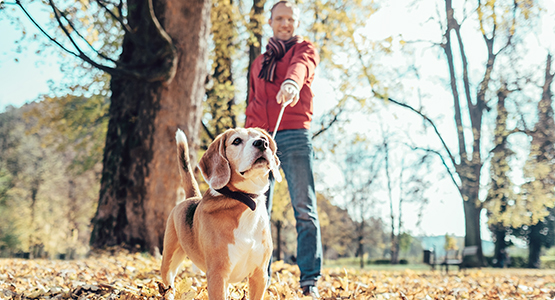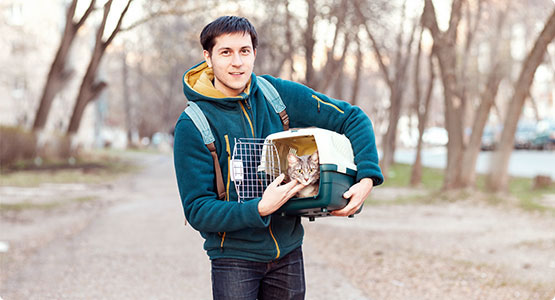Tips for flying with your pet
Whether you want to take a vacation or you are relocating yourself, your pet will most certainly come along. While the familial feelings and the excitement of visiting and experiencing a new place together is uncontained, there are concerns abound. “Can I fly with my pet?”, “Will my pet feel comfortable in a flight?”, “Is it safe?”, “What is the process?”, “What do I need?”, “And what will be my pets requirements?” There are no invalid questions and the worries are truly endless. But having a safe and fulfilling travel experience with your pet isn’t unheard of and all you need to do is make a plan and take off. But first, a slight detour. Here are a few tips that can come in handy and bust all your uncertainties when flying with a pet.

Pets need vets
First and foremost, you need to make an appointment with your pet’s veterinarian. It is of utmost importance that before you make any concrete plans, you get the vet’s go-ahead. Let them know of your travel plans and they can assess if the pet is healthy enough to make the trip. Post this, you can proceed with further travel planning. Another visit to the vet will be needed closer to the departure date when you most likely will be needing a pet health certificate issued along with a few other forms and documents (check your particular airline’s requirements). The veterinarian can and will help you with those.

Restrictions on the breed
Many airlines are now putting restrictions on brachycephalic breeds (snub nosed breeds) because of possible health risks to them. Due to their small noses, the animals can have trouble breathing, especially at high altitudes. Respiratory troubles can increase even further with extreme temperatures - either too hot or too cold. For better planning, it is advisable to check with the airlines about any restrictions that may fit your pet.

Cabin or Cargo
Your pet’s size, weight and temperament are all to be accounted for when you are making the big choice between an in-cabin travel or a cargo hold for your pets journey. Small pets whose crates can be accommodated under the flight seat can travel in-cabin. Make sure you check the crate size and weight regulations that may vary for each airline. For large pets, there are separate cargo holds that ensure your pet gets the due care and travels comfortably. To ease your mind you can always speak to the airline about their facilities. Also note that if your pet tends to get aggressive or may pee accidentally, the airline may not allow for your pet to travel in the cabin alongside other passengers. It is always better to clarify such concerns with the airlines beforehand.
Early bird bookings
Pet friendly airlines, usually have a limit to the number of pets that can travel per flight. It then becomes very important that you find your desired flights and reserve your spot in advance. It will save everyone some time and inconvenience if before making bookings, you speak to the airlines regarding availability of space for your pet. On getting a pet capacity update from the airline, you can book your seats hassle free.
Carry a carrier
Be it an in-cabin or a cargo hold journey, a carrier for your pet is a must. Whatever the specie or the breed, there is an appropriate carrier for your pet. For small pets who can travel in the cabin with you, you may opt for a soft sided carrier that can go under your seat. Do check with the airline about the dimensions of the crate that can be permitted in the cabin area. For larger pets you will have to opt for a hard sided carrier with ventilation holes. To make it comfortable for your pet and for the airline to allow the transportation of your pet, it is essential that the space in the carrier allows your pet to adequately stand, sit, turn around and lie down.
Make it homely
Traveling can be a cause of anxiety for you and even more so, for your pet. An unknown environment can visibly do that to a pet. To help your pet feel as comfortable as possible, it is suggested that you acclimatize your pet with the crate. A few days before your travel date, you can start feeding and taking your pet out in the said crate. What will help even further is if you decorate the crate with things that are familiar to your pet like his/her blanket and favorite toys.
Don’t sedate
The American Veterinary Medical Association says that in most cases pets should not be given sedatives or tranquilizers because that can interfere with their respiratory and cardiovascular functions as and when they will be exposed to altitudinal pressure. We understand you are scared about your pet’s experience but sedatives aren’t the answer. And if at all that is necessitated, it should be done with the consultation of a veterinarian.
Playtime
Don’t feed your pet right before the flight because that may make him/her uncomfortable while airborne. Refrain from giving too much water just before the flight as well. Feed your pet and even give them enough time and space to relieve themselves. Many airlines do have facilities like enclosed grassy areas for the same. Close to the boarding time, take your pet out for a walk or give them some play time. This is so that they tire themselves out and will most likely just doze off during the flight making it an enjoyable journey for everyone.
Early Bird arrival
Reaching the airport early with your pet is surely a plus. Arriving early can give you and your pet the required extra couple of minutes to settle down. Most airlines recommend arriving at the airport at least two hours before your flight time. But keep in mind that no pets are allowed to board more than four hours before the boarding time.
Take ‘em treats
A happy pet travels healthy and safe. Bring lots of treats so that your pet is in a joyful state of mind. A chew toy also works equally well as that will also help ease any discomfort caused by the building up of pressure in your pet’s ears(just like humans).
And well, well, if you keep these tips in mind, your flight time will be no less than a treat either. Pawsome travels!

 How to plan a trip with your pet?
How to plan a trip with your pet?
 Traveling with Service Animals/ Emotional Support Animals/ Psychiatric Animals
Traveling with Service Animals/ Emotional Support Animals/ Psychiatric Animals
 What is the difference between cabin, cargo and baggage travel?
What is the difference between cabin, cargo and baggage travel?
 How much will traveling with my pet cost?
How much will traveling with my pet cost?
 Vacation plans? Not without your pets!
Vacation plans? Not without your pets!
 Why it is mandatory to visit a vet before pet travel
Why it is mandatory to visit a vet before pet travel
 What is a pet passport and does my pet need it?
What is a pet passport and does my pet need it?
 Halloween: Safety Tips for Pets
Halloween: Safety Tips for Pets
 Best Places to be with your pet for Halloween
Best Places to be with your pet for Halloween